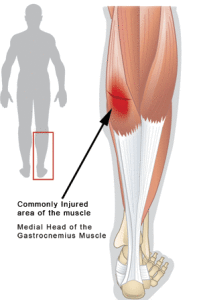Calf Strain (Tennis Leg)
Calf Pain in a Recreational Tennis Player: More than Just a Pain in your Heel
You stretch to hit the perfect volley when “Pop!” a ball hits you in the back of the leg. Or did it? Pain sears through your calf muscle. There’s no ball in sight. It has probably happened to you or someone you know. It’s commonly called “Tennis Leg” and it is one of three calf injuries common to tennis players. These injuries are even more common in recreational players whose conditioning, flexibility, and muscle endurance are suboptimal. In the unconditioned athlete sudden bursts of extended physical activity put muscles, tendons, and bones at risk for injury.
Calf Pain in recreational tennis players can generally be attributed to one of three injuries–Tennis Leg, Achilles Tendonitis or Achilles Tendon Ruptures.
 Upper to mid-calf injuries below the knee (typically medial vs. lateral gastrocnemius muscle) are typically called “Tennis Leg” due to their prevalence in this sport. Lunging forward puts maximal tension on the back leg when the knee is extended and the foot dorsiflexed (pulled upwards). Maximal contraction in this lengthened muscle results in strains and tears. This injury is more common in those who are forty to sixty years of age and also more common in men than in women. While some have no noticeable signs prior to injury, 20% of patients report calf tightness several days before the injury. If you feel acute calf pain in this area, stop playing and see a doctor. Treatment involves rest, immobilization (walking boot), anti-inflammatory medications, ice, and physical therapy. Return to play is allowed when you are pain-free and 90% as strong as the good leg – up to several weeks later depending on partial (strain) vs. complete tears. There is a 40% chance it will happen again – on either leg.
Upper to mid-calf injuries below the knee (typically medial vs. lateral gastrocnemius muscle) are typically called “Tennis Leg” due to their prevalence in this sport. Lunging forward puts maximal tension on the back leg when the knee is extended and the foot dorsiflexed (pulled upwards). Maximal contraction in this lengthened muscle results in strains and tears. This injury is more common in those who are forty to sixty years of age and also more common in men than in women. While some have no noticeable signs prior to injury, 20% of patients report calf tightness several days before the injury. If you feel acute calf pain in this area, stop playing and see a doctor. Treatment involves rest, immobilization (walking boot), anti-inflammatory medications, ice, and physical therapy. Return to play is allowed when you are pain-free and 90% as strong as the good leg – up to several weeks later depending on partial (strain) vs. complete tears. There is a 40% chance it will happen again – on either leg.
Historically, plantaris tendon ruptures have been called Tennis Leg. When stepping hard off the feet or charging the net, players complain of a “whip-like sting” and “snap” in the calf. Functionally, the plantaris muscle is of little importance so transient disability is due only to the pain of torn fibers or swelling from the hemorrhage. Most instances of Tennis Leg are now felt to be due to partial tears of the medial gastrocnemius muscle.
Another common tennis injury is Achilles Tendonitis. Pain in the back of the heel is most often due to inflammation of the Achilles tendon caused by overuse and poor flexibility common in adults in their 30’s and 40’s. If the Achilles tendon is sore, or aches, stop and rest it. The biggest cause of chronic tendonitis is ignoring early warning signs and pushing through pain. Achilles tendonitis can be prevented and treated with proper warm-up, stretching, anti-inflammatory medications, and ice as needed. Avoid steroid injections into this area because they significantly increase the chance of a rupture. It is not necessary to stop activity completely (consider cross training) as long as you pay attention to muscle soreness and reduce activity accordingly.
While inflammation of the Achilles tendon can cause severe pain, a rupture of this same tendon is a very different injury. Athletes who rupture their Achilles tendon often say it feels like they have been shot in the back of the leg. More severe than tendonitis, this is not a particularly painful injury, and a player may be lulled into thinking that the injury is not as severe as it really is. Ruptures typically occur after age 30; up to one third of patients will feel Achilles tendon pain several days beforehand. Gout, hyperparathyroidism, steroid injections and/or flouroquinolone antibiotics (ex. ciprofloxacin, levaquin) all increase the risk of ruptures. After an Achilles tendon rupture, a player will be able to walk flat-footed, but will not be able to stand up on his or her toes on the affected side. A Thompson Test differentiates between a Tennis Leg and Achilles Rupture. The test is performed with the patient prone and the knee flexed. If squeezing the calf muscle does not cause the foot to point down (plantarflex) then the test is positive and the Achilles tendon is ruptured. Treatment can consist of casting or surgery, but surgery is recommended for most Achilles tendon ruptures, especially for athletes.
So you’re a 40-year-old recreational tennis player who gives it all he’s got every Saturday morning. Is a lower leg injury in your future? Not necessarily. Prevention is the key for this spectrum of calf pain. The unifying cause in Tennis Leg and Achilles tendon injuries is a tight calf muscle-Achilles tendon unit. This unit crosses both the knee and ankle. You can tell if this unit is tight if you cannot raise the ball of your foot higher than the heel of that foot with the leg extended. It is vital for a recreational athlete to continually work on muscle strength, endurance and flexibility in order to avoid these injuries. Should you experience any symptoms of these injuries seek medical attention, ideally from a sports medicine specialist, such as an orthopedic surgeon with advanced sports training.
